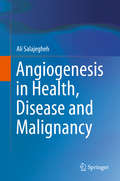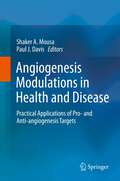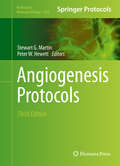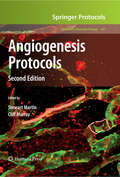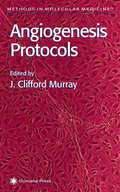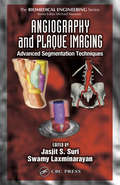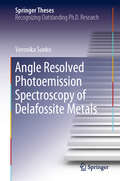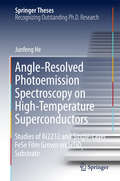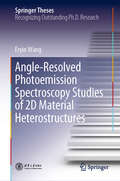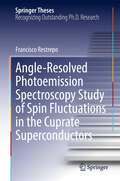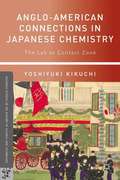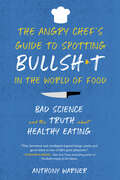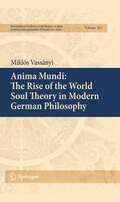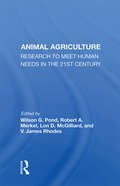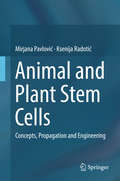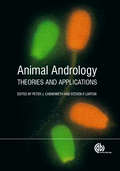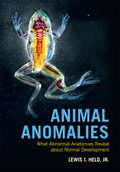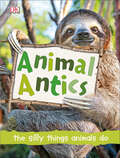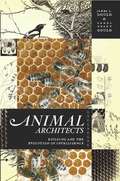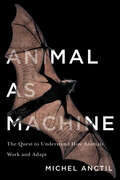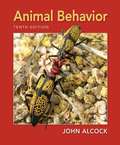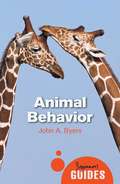- Table View
- List View
Angiogenesis in Health, Disease and Malignancy
by Ali SalajeghehThis book is about "Angiogenesis". A process in which new vasculature is formed from pre-existing capillaries. Angiogenesis process is associated with the proliferation and growth of both physiologically normal and neoplastic tissues, through the formation of vascular supply, essential for delivering growth requirements such as oxygen and nutrients. The book describes more than 100 genes and their key regulatory functions in the context of normal healthy condition, disease and malignancy, cancer proliferation and progression. New insights into the role of angiogenesis and the therapeutic inhibition of its regulators are investigated, due to the great potential for exploitation in the development of a novel treatment for cancer. New scientists, junior researchers and biomedical science students will find this book an invaluable introductory reference to their insight about angiogenesis and angiogenic role of more than 100 angiogenes and their role in healthy, disease and malignant conditions.
Angiogenesis Modulations in Health and Disease: Practical Applications of Pro- and Anti-angiogenesis Targets
by Shaker A. Mousa Paul J. DavisThis book is a major update of novel targets in angiogenesis modulation, including pro- and anti-angiogenesis. There is in-depth coverage of preclinical and clinical methods and models, investigational status, and clinical applications. The impact of nanotechnology in advancing the applications of pro-and anti-angiogenesis strategies is also highlighted, along with stem cell and biotechnologies in research and development of angiogenesis modulating targets.
Angiogenesis Protocols (Methods in Molecular Biology #1430)
by Stewart G. Martin Peter W. HewettInaddition to updating important core techniques this third edition presents newchapters on assessing leukocyte involvement in angiogenesis, lymphatic cell andpericyte isolation techniques, spheroid and arterial ring based in vitroassays, and on pericyte involvement in angiogenesis. Angiogenesis Protocols,Third Edition also guides readers through new protocols on chorioallantoicmembrane models, corneal pocket assays to assess angio- and lymphangiogenesis,models of muscle angiogenesis, and use of zebrafish embryos to study vascularangiogenesis and senescence. Written in the highly successful Methods inMolecular Biology series format, chapters include introductions to theirrespective topics, lists of the necessary materials and reagents, step-by-step,readily reproducible laboratory protocols, and tips on troubleshooting andavoiding known pitfalls. Authoritativeand practical, Angiogenesis Protocols, Third Edition provides not only apractical handbook for key techniques, but also an informative and enjoyableread for all those interested, no matter how directly, in angiogenesis.
Angiogenesis Protocols (Methods in Molecular Biology #467)
by Cliff Murray Stewart MartinAs experimentation and clinical trials with first generation anti-angiogenic agents have yielded results and our understanding of the biology and physiology of blood and lymphatic vessels has increased, a new angiogenesis volume swiftly became a necessity. Angiogenesis Protocols, Second Edition remains true to its original vision of providing a single source for angiogenesis researchers, irrespective of levels of resource and expertise, by collecting a range of methods for cell isolation and assessing angiogenesis in vivo or in vitro. This information, however, is expanded to include chapters on circulating endothelial progenitor cells, angiogenic signalling pathways, imaging of angiogenesis, and measurement of tissue blood flow. Written in the Methods in Molecular BiologyTM series format, the chapters provide step-by-step laboratory protocols, lists of necessary materials and reagents, and a Notes section, which details tips on troubleshooting and avoiding known pitfalls. Extensive and cutting-edge, Angiogenesis Protocols, Second Edition is not only a practical handbook for key techniques, but also an informative and enjoyable read for all those interested, no matter how directly, in angiogenesis.
Angiogenesis Protocols (Methods in Molecular Medicine #46)
by J. Clifford MurrayA comprehensive collection of key techniques for assessing the formation of new blood vessels in both whole tissues and cell culture. These readily reproducible methods range from low-cost in vitro assays to cutting-edge in vivo models, such as the dorsal window chamber, which demands high levels of surgical skill as well as relatively expensive, custom-made equipment. Timely and highly practical, Angiogenesis Protocols is a gold-standard resource for today's angiogenesis investigator, providing easy access to a wide variety of proven assays suitable for laboratories with greatly differing technical expertise, materials, and financial resources.
Angiography and Plaque Imaging: Advanced Segmentation Techniques (Biomedical Engineering Ser.)
by Jasjit S. Suri Swamy LaxminarayanRecent, rapid advances in mathematical engineering and applied mathematics have opened the door to solving complex problems in angiography imaging. For the first time, this book presents the different medical imaging modalities--MR, CT, x-ray, and ultrasound--for performing angiography and its analysis. Pioneers from a variety of relevant disciplin
Angle Resolved Photoemission Spectroscopy of Delafossite Metals (Springer Theses)
by Veronika SunkoThis thesis describes the results of angle resolved photoemission spectroscopy experiments on delafossite oxide metals, and theoretical work explaining these observations. The study was motivated by the extraordinarily high conductivity of the non-magnetic delafossites PdCoO2 and PtCoO2, the measurement of whose electronic structure is reported and discussed. Two unexpected effects were observed in the course of the investigation; each is described and analysed in detail. Firstly, a previously unrecognised type of spectroscopic signal, allowing the non-magnetic probe of photoemission to become sensitive to spin-spin correlations, was observed in the antiferromagnetic PdCrO2. Its origin was identified as the Kondo-like coupling of itinerant and Mott insulating electrons. Furthermore, surface states exhibiting an unusually large Rashba-like spin-splitting were observed on the transition metal terminated surfaces of delafossites. The large inversion symmetry breaking energy scale, a consequence of the unusual structure of the surface layer, is identified as the origin of the effect.
Angle-Resolved Photoemission Spectroscopy on High-Temperature Superconductors: Studies of Bi2212 and Single-Layer FeSe Film Grown on SrTiO3 Substrate (Springer Theses)
by Junfeng HeThis book mainly focuses on the study of the high-temperature superconductor Bi2Sr2CaCu2O8+δ (Bi2212) and single-layer FeSe film grown on SrTiO3 (STO) substrate by means of angle-resolved photoemission spectroscopy (ARPES). It provides the first electronic evidence for the origin of the anomalous high-temperature superconductivity in single-layer FeSe grown on SrTiO3 substrate. Two coexisted sharp-mode couplings have been identified in superconducting Bi2212. The first ARPES study on single-layer FeSe/STO films has provided key insights into the electronic origin of superconductivity in this system. A phase diagram and electronic indication of high Tc and insulator to superconductor crossover have been established in the single-layer FeSe/STO films. Readers will find essential information on the techniques used and interesting physical phenomena observed by ARPES.
Angle-Resolved Photoemission Spectroscopy Studies of 2D Material Heterostructures (Springer Theses)
by Eryin WangThis book focuses on angle-resolved photoemission spectroscopy studies on novel interfacial phenomena in three typical two-dimensional material heterostructures: graphene/h-BN, twisted bilayer graphene, and topological insulator/high-temperature superconductors. Since the discovery of graphene, two-dimensional materials have proven to be quite a large “family”. As an alternative to searching for other family members with distinct properties, the combination of two-dimensional (2D) materials to construct heterostructures offers a new platform for achieving new quantum phenomena, exploring new physics, and designing new quantum devices. By stacking different 2D materials together and utilizing interfacial periodical potential and order-parameter coupling, the resulting heterostructure’s electronic properties can be tuned to achieve novel properties distinct from those of its constituent materials. This book offers a valuable reference guide for all researchers and students working in the area of condensed matter physics and materials science.
Angle-Resolved Photoemission Spectroscopy Study of Spin Fluctuations in the Cuprate Superconductors (Springer Theses)
by Francisco RestrepoThis thesis makes significant advances towards an understanding of superconductivity in the cuprate family of unconventional, high-temperature superconductors. Even though the high-temperature superconductors were discovered over 35 years ago, there is not yet a general consensus on an acceptable theory of superconductivity in these materials. One of the early proposals suggested that collective magnetic excitations of the conduction electrons could lead them to form pairs, which in turn condense to form the superconducting state at a critical temperature Tc. Quantitative calculations of Tc using experimental data were, however, not available to verify the applicability of this magnetic mechanism. In this thesis, the author constructed an angle-resolved photoemission apparatus that could provide sufficiently accurate data of the electronic excitation spectra of samples in the normal state, data which was furthermore unusually devoid of any surface contamination. The author also applied the Bethe-Salpeter method to his uncommonly pristine and precise normal state data, and was able to predict the approximate superconducting transition temperatures of different samples. This rare combination of experiment with sophisticated theoretical calculations leads to the conclusion that antiferromagnetic correlations are a viable candidate for the pairing interaction in the cuprate superconductors.
Anglo-american Connections In Japanese Chemistry
by Yoshiyuki KikuchiAnglo-Japanese and American-Japanese connections in chemistry had a major impact on the institutionalization of scientific and technological higher education in Japan from the late nineteenth century and onwards. They helped define the structure of Japanese scientific pedagogical and research system that lasted well into the post-World World II period of massive technological development, when it became one of the biggest providers of chemists and chemical engineers in the world next to Europe and the United States. In telling this story, Anglo-American Connections in Japanese Chemistry explores various sites of science education such as teaching laboratories and classrooms - where British and American teachers mingled with Japanese students - to shed new light on the lab as a site of global human encounter and intricate social relations that shaped scientific practice.
The Angry Chef's Guide to Spotting Bullsh*t in the World of Food: Bad Science And The Truth About Healthy Eating
by Anthony WarnerJust say no to nutri-nonsense Why is Chef Anthony Warner so angry? Two words: pseudoscience bullshit. Lies about nutrition are repeated everywhere—in newspaper headlines, on celebrity blogs, even by our well-meaning friends and family. Bad science is no reason to give up good food (we miss you, bread)! It’s high time to distinguish fact from crap. As the Angry Chef, Warner skewers common food myths that range from questionable (“coconut oil is a weight-loss miracle”) to patently dangerous (“autism is caused by toxins”). He also cuts down a host of fad diets—including the paleo diet and the infamous detox. Warner goes on to explain why we’re so easily misled: It has a lot to do with our instinctive craving for simple explanations and straightforward rules. With help from “Science Columbo,” he pares away poisonous rhetoric and serves up the delicious, nuanced truth (with a side of saucy humor). Bon appétit!
The Angular Momentum of Light
by David L. Andrews Mohamed BabikerRecent developments in the angular momentum of light present fresh challenges to long established concepts and pave the way for new and wide-ranging applications. The scope for structured light such as optical vortices, in particular, now extends from microfluidics to quantum information. This is the first comprehensive edited collection dealing with light carrying spin and orbital angular momentum, covering both fundamental and applied aspects. Written by internationally leading specialists, the chapters have been compiled to reflect the latest scientific progress and to address the multitude of theoretical, experimental and technical issues associated with this vibrant and exciting field. The volume is an authoritative reference for academic researchers and graduate students engaged in theoretical or experimental study of optical angular momentum and its applications. It will also benefit professionals in physics, optics and optical engineering, chemistry and biology.
Anima Mundi: The Rise Of The World Soul Theory In Modern German Philosophy (International Archives of the History of Ideas Archives internationales d'histoire des idées #202)
by Miklós VassányiThis work presents and philosophically analyzes the early modern and modern history of the theory concerning the soul of the world, anima mundi. The initial question of the investigation is why there was a revival of this theory in the time of the early German Romanticism, whereas the concept of the anima mundi had been rejected in the earlier, classical period of European philosophy (early and mature Enlightenment). The presentation and analysis starts from the Leibnizian-Wolffian school, generally hostile to the theory, and covers classical eighteenth-century physico-theology, also reluctant to accept an anima mundi. Next, it discusses early modern and modern Christian philosophical Cabbala (Böhme and Ötinger), an intellectual tradition which to some extent tolerated the idea of a soul of the world. The philosophical relationship between Spinoza and Spinozism on the one hand, and the anima mundi theory on the other is also examined. An analysis of Giordano Bruno's utilization of the concept anima del mondo is the last step before we give an account of how and why German Romanticism, especially Baader and Schelling asserted and applied the theory of the Weltseele. The purpose of the work is to prove that the philosophical insufficiency of a concept of God as an ens extramundanum instigated the Romantics to think an anima mundi that can act as a divine and quasi-infinite intermediary between God and Nature, as a locum tenens of God in physical reality.
Animal Agriculture: Research To Meet Human Needs In The 21st Century
by Wilson G. PondFirst published in 1980. Animal agriculture serves human needs. Three-fourths of the protein, one-third of the energy, most of the calcium and phosphorus and substantial amounts of essential vitamins and other minerals in the American diet are from animal products. Recognizing that innovative research holds the key to meeting these challenges, 210 concerned individuals convened at Boyne Mountain, Michigan, May 4 to 9, 1980. Their goal was to identify priorities for future research to enable animal agriculture to efficiently and effectively serve human needs in the 21st century. These proceedings represent the best collective judgment on research priorities by a group of informed and dedicated people concerned with the future role of animal agriculture in meeting human needs.
Animal and Plant Stem Cells: Concepts, Propagation and Engineering
by Mirjana Pavlović Ksenija RadotićThis book provides a multifaceted look into the world of stem cells and explains the similarities and differences between plant and human stem cells. It explores the intersection between animals and plants and explains their cooperative role in bioengineering studies. The book treats both theoretical and practical aspects of stem cell research. It covers the advantages and limitations of many common applications related to stem cells: their sources, categories, engineering of these cells, reprogramming of their functions, and their role as novel cellular therapeutic approach. Written by experts in the field, the book focuses on aspects of stem cells ranging from expansion-propagation to metabolic reprogramming. It introduces the emergence of cancer stem cells and different modalities in targeted cancer stem cell therapies. It is a valuable source of fresh information for academics and researchers, examining molecular mechanisms of animal and plant stem cell regulation and their usage for therapeutic applications. Students at all levels of medical or engineering backgrounds will enjoy the case studies that illustrate and explain mechanisms, interactions, targeted effects, and multimodal therapeutic approaches. Academics, researchers, and professionals who want to expand their knowledge in this field will find this book an exceptional resource.
Animal Andrology: Theories and Applications
by Brian P Brian P William E William E Abdullah Abdullah Sema Sema Lefric Lefric Erdogan Erdogan Bart M Bart M William L William L M Linda Linda Francoise J Francoise J Margaret V Margaret V Julie A Julie A Swanand Swanand Clifford F Clifford FUnderstanding animal andrology is fundamental to optimising genetic breeding traits in domestic and wild animals. This book provides extensive coverage of male reproductive biology, discussing the essentials of sperm production, harvest and preservation before covering the applications to a range of animals including cattle, horses, pigs, small ruminants, camelids, cats and dogs, poultry and exotic species. It also examines the laboratory procedures that provide the basis of general fertility research.
Animal Andrology
by William E William E Brian P Brian P Lefric Lefric Steven Lorton Francoise J Francoise J Julie A Julie A Erdogan Erdogan Bart M Bart M Sema Sema Abdullah Abdullah Clifford F Clifford F William L William L M Margaret V Margaret V Linda Linda Peter J Chenoweth Swanand SwanandUnderstanding animal andrology is fundamental to optimising genetic breeding traits in domestic and wild animals. This book provides extensive coverage of male reproductive biology, discussing the essentials of sperm production, harvest and preservation before covering the applications to a range of animals including cattle, horses, pigs, small ruminants, camelids, cats and dogs, poultry and exotic species. It also examines the laboratory procedures that provide the basis of general fertility research.
Animal Anomalies: What Abnormal Anatomies Reveal about Normal Development
by Lewis I. Held, JrAmong the offspring of humans and other animals are occasional individuals that are malformed in whole or in part. The most grossly abnormal of these have been referred to from ancient times as monsters, because their birth was thought to foretell doom; the less severely affected are usually known as anomalies. This volume digs deeply into the cellular and molecular processes of embryonic development that go awry in such exceptional situations. It focuses on the physical mechanisms of how genes instruct cells to build anatomy, as well as the underlying forces of evolution that shaped these mechanisms over eons of geologic time. The narrative is framed in a historical perspective that should help students trying to make sense of these complex subjects. Each chapter is written in the style of a Sherlock Holmes story, starting with the clues and ending with a solution to the mystery.
Animal Antics
by DKHave you ever wondered how ants carry up to 50 times their body weight? Or why sloths move so slowly? Discover the answers to these questions and more as you laugh along at the hilarious pictures in this fun non-fiction book for kids.Animal Antics is jam-packed with funny photos of animals in action. Look out for goats popping up in unexpected places, zebras and chimpanzees grinning for the camera, and adorable chipmunks with bulging cheeks. Alongside high quality images, each page features mind-boggling facts about your favourite animals, including how they get around, what they like to eat, and how they stay cool or keep warm.Children will love this fresh glimpse into the lives of loads of weird and wonderful animals.
Animal Architects: Building and the Evolution of Intelligence
by James L. Gould Carol Grant GouldAnimal behavior has long been a battleground between the competing claims of nature and nurture, with the possible role of cognition in behavior as a recent addition to this debate. There is an untapped trove of behavioral data that can tell us a great deal about how the animals draw from these neural strategies: The structures animals build provide a superb window on the workings of the animal mind. Animal Architects examines animal architecture across a range of species, from those whose blueprints are largely innate (such as spiders and their webs) to those whose challenging structures seem to require intellectual insight, planning, and even aesthetics (such as bowerbirds’ nests, or beavers’ dams). Beginning with instinct and the simple homes of solitary insects, James and Carol Gould move on to conditioning; the "cognitive map” and how it evolved; and the role of planning and insight. Finally, they reflect on what animal building tells us about the nature of human intelligence-showing why humans, unlike many animals, need to build castles in the air.
Animal as Machine: The Quest to Understand How Animals Work and Adapt
by Michel AnctilThrough the ages natural historians have puzzled over how animals work, wavering between a vitalist belief in a soul animating bodily functions and a mechanistic outlook in which animal body parts are seen as pieces of organic machinery.Animal as Machine explores the life, work, and ideas of scientists who, branding themselves as physiologists, subscribed to mechanistic concepts to explain how animals acquire and process food, breathe, circulate their blood, and sense their environment. As medical physiology thrived in the nineteenth century, zoologists struggled to forge their own distinctive physiology predicated on understanding animal functions in a context of environmental adaptation and evolutionary forces. Physiological schools with distinct emphases that shaped their outlook sprang up around the world. Dividing their time between fieldwork in marine stations and laboratory experimentation, animal physiologists stood in awe of the diversity and ingenuity of the functional strategies by which animals survived.Animal as Machine tells a remarkable and insightful story of the larger-than-life personalities and gripping historical episodes that marked the emergence and blossoming of animal physiology.
Animal Behavior: An Evolutionary Approach
by John AlcockThe tenth edition features a major reorganisation, focusing first on the evolutionary basis of behavior followed by the underlying proximate mechanisms. Enduring features of previous editions also remain; the clear engaging writing style, the beautifully illustrated text with many new photographs and numerous references to new scientific articles.
Animal Behavior: A Beginner's Guide (Beginner's Guides)
by John ByersWhy do birds have regional accents? Can horses learn math? What do animals without eyes see? Questions such as these have fascinated scientists and animal lovers alike long before ethology - the study of animal behavior - became recognized as a science in the 1970s. Now, as issues of conservation and welfare dominate the field, an understanding of how and why animals act the way they do has become even more critical.Communicating the passion of the scientists who have driven the discipline, John Byers draws together evolutionary theory, ecology, population biology, genetics, physiology, and anatomy to demonstrate the diversity involved when studying animals. By explaining the mechanisms and motivations behind a range of animal movements he illuminates key issues about our own behavior while equipping readers with the core knowledge and skills to further their own studies.
